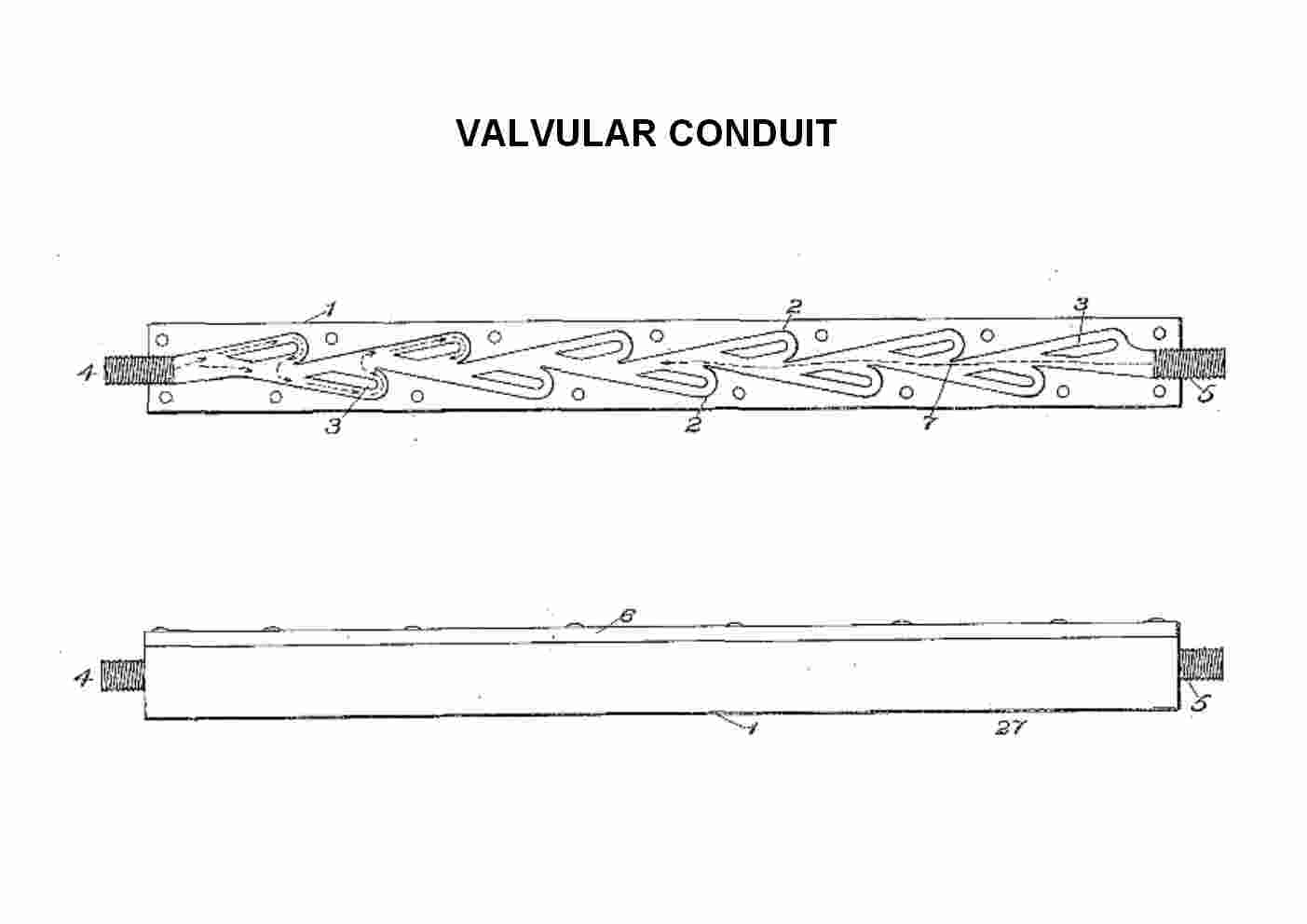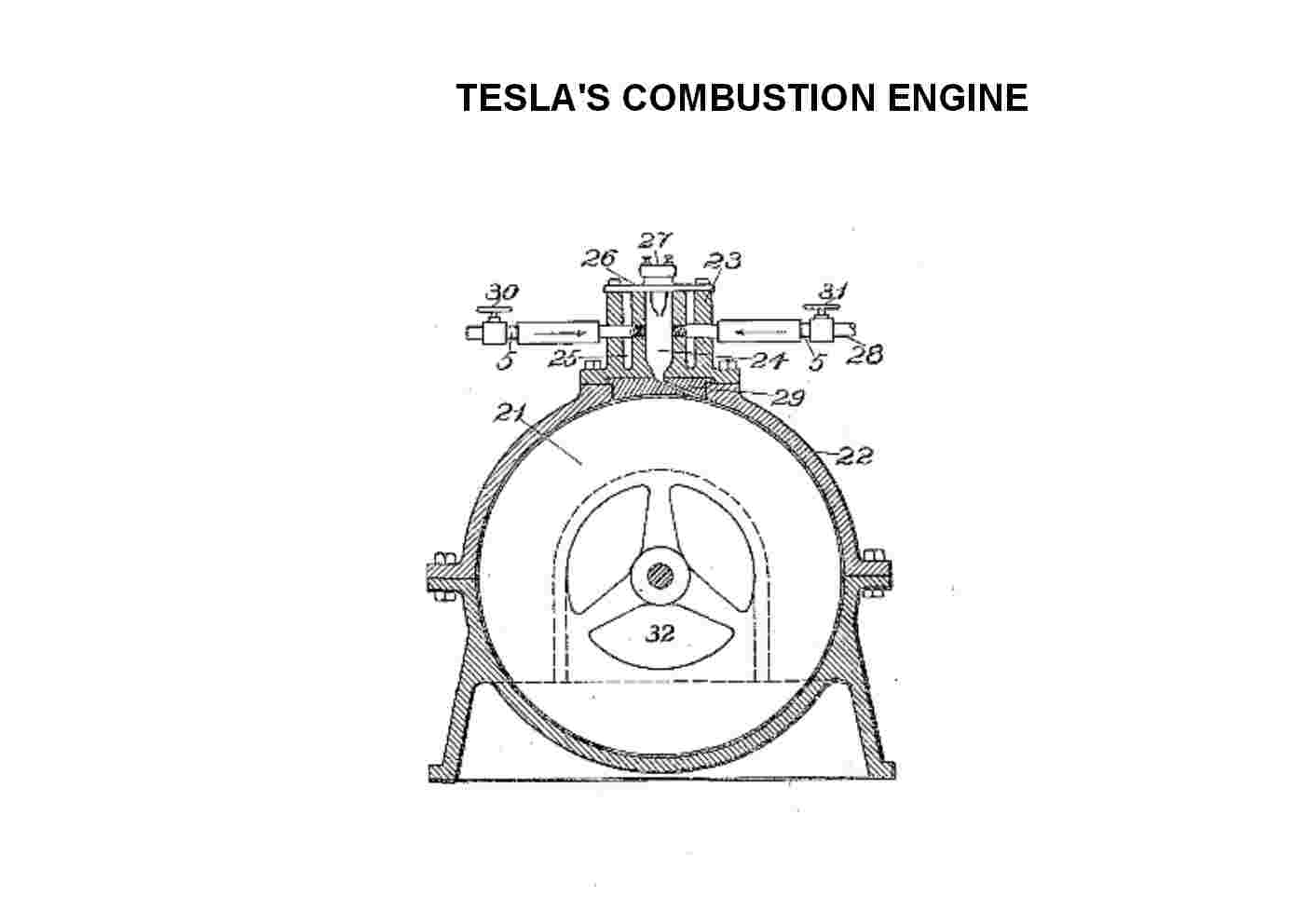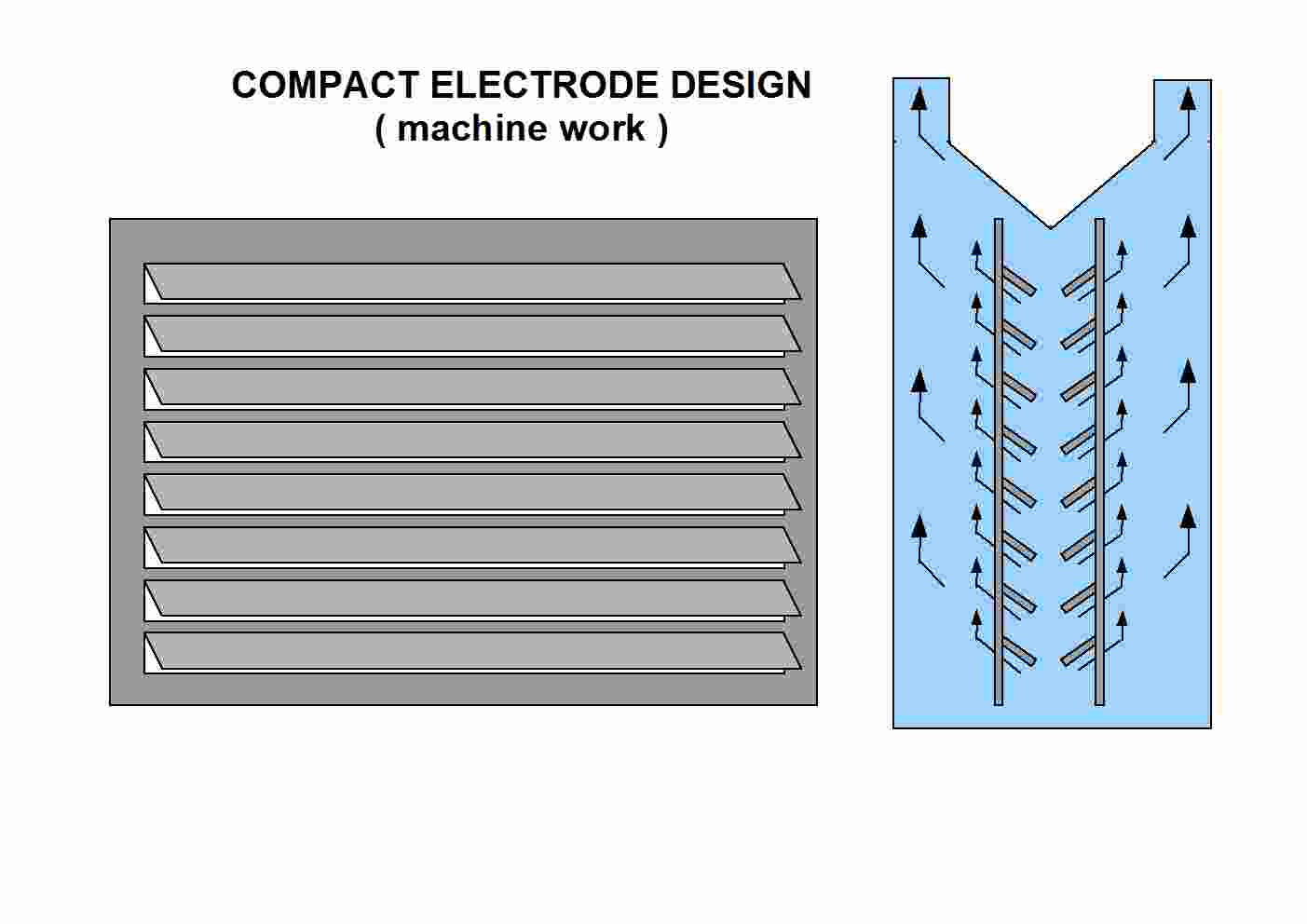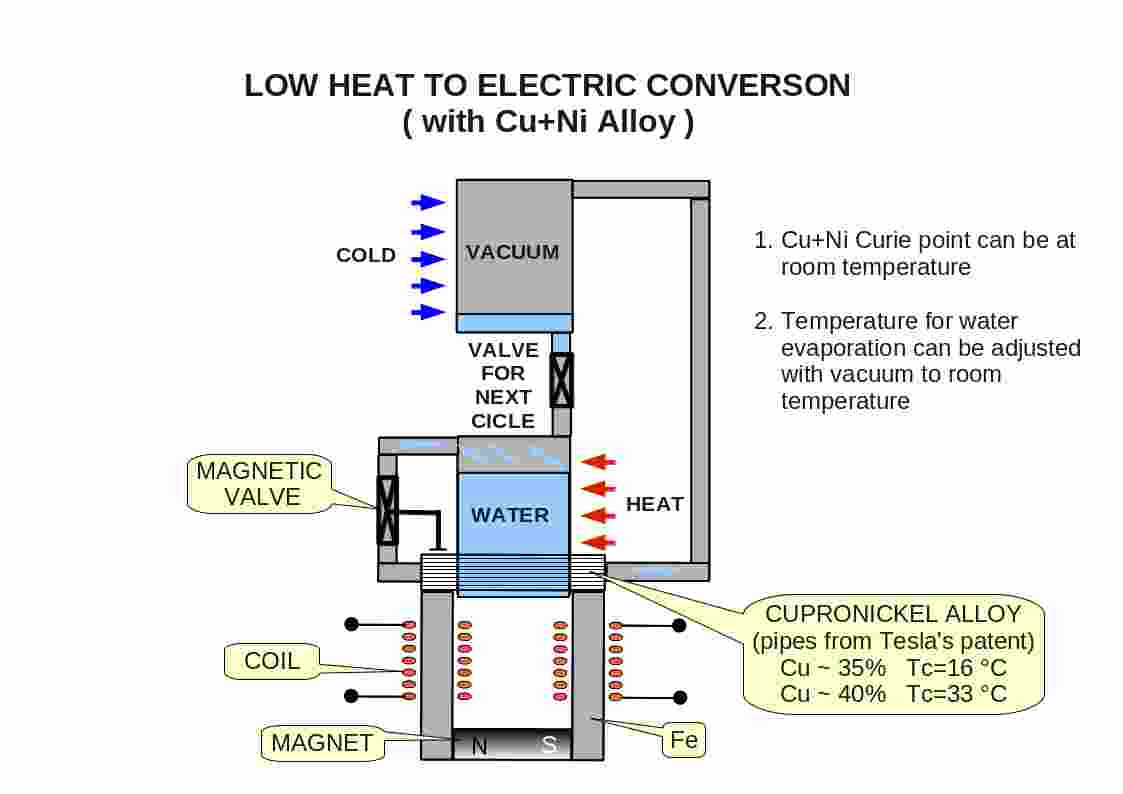
NIKOLA TESLA'S INTERNAL COMBUSTION ENGINE
MY MODIFICATION OF MOTOR DESIGN
TESLA'S COMBUSTION MOTOR DESIGN
BIOMASS GASIFICATION ENERGY SOURCE
LOW HEAT TO ELECTRIC CONVERSON (with Cu+Ni Alloy)
.
.
.
.
.
.
.
.
.
.
.
.
.
.
.
.
.
.
.
.
.
.
.
.
.
.
.
.
.
.
.
.
.
.
.
.
.
.
.
.
.
.
MY MODIFICATION OF MOTOR DESIGN:


This motor is my modification on Tesla motor explain in patent: 1,329,559 'Valvular conduit'.
Fluid (air and fuel) can pass 'Valvular conduit' only in one direction. It function without the use of moving parts.
Exhaust of motor is in midle of rotating shaft. Bearings is between stator and rotor.
Burning chamber is between two circural case. It has holes in angle for spiral blast of burning fuel.
Rotation of rotor will sucking fresh air/fuel mixture and it will continue in impulse regime (sucking/explosion).
It works like jet motor with rotation of disks on exhaust.
Spark can be part of Tesla high frequency transformer, and its output can be used for lighting purpose (car light).
Material can be Si3N4 (silicon nitride), but it is not cheap.
.
.
.
.
.
.
.
.
.
.
.
.
.
.
.
.
.
.
.
.
.
.
.
.
.
.
.
.
.
.
.
.
.
.
.
.
.
.
.
.
.
.

This is orginal Tesla's design from his patent. I am rotate and zoom that picture.
.
.
.
.
.
.
.
.
.
.
.
.
.
.
.
.
.
.
.
.
.
.
.
.
.
.
.
.
.
.
.
.
.
.
.
.
.
.
.
.
.
.
TESLA'S COMBUSTION MOTOR DESIGN:

This is orginal Tesla's design from his patent. I am rotate and zoom that picture.
.
.
.
.
.
.
.
.
.
.
.
.
.
.
.
.
.
.
.
.
.
.
.
.
.
.
.
.
.
.
.
.
.
.
.
.
.
.
.
.
.
.
This is new (patented) system from John Kanzius discovery (cancer researcher). Salt water in high frequency field, can crack water to H2 and O2. Simply and beautiful electrolysis. I am fascinated with this discovery. I don't know detail, but generator is around Tesla transformer frequency, and around 1 KW power for test tube flame. Electricity can be convert directly to fire. Like Tesla's proposal for make aluminum.
I am ading this information, because I think it is interesting.
.
.
.
.
.
.
.
.
.
.
.
.
.
.
.
.
.
.
.
.
.
.
.
.
.
.
.
.
.
.
.
.
.
.
.
.
.
.
.
.
.
.
I am finally satisfied with my new system for extract hydrogen and oxygen from water with electricity. This is great improvement on this field. I am learning from lot of other devices, and do it on my way.
First problem which I see in that kind of devices is use dangerous chemicals. NaOH or KOH has problem with aluminum, and with water they are danger.
Second problem which I see is mix of hydrogen and oxygen. I don't like it. Thats gas must be separate on device output.
Third problem is energy consumption in electrolytic process. I will try to work on recycle that passing energy through cells, with transforming in high frequency. For now I just try build perfect electrolytic device. And free of patents, of course. That is purpose of my web diary.
Let start from first problem, with little theory...
Natural electric part in water is H+ and OH- ions (that is H2O). Cathode (-) will catch that part with + sign (H+). Between two electrode we need some system for transport that OH- part. When this transportation chain come to + electrode, oxygen is extract from that. First and last molecule are important. Transportation chain in the middle is just electricity conduction path.
NaOH has that Na+ and OH- part. That OH- make that chain path, from first molecule on first plate to last on another. But I don't like NaOH or KOH danger properties.
Because of that I choose NaHCO3 (baking soda or sodium bicarbonate). It has that Na+ and O-CO2-OH- part. That OH- part will do that transportation path. It is cheap (use in kitchen), with low danger. It is perfect. NaCl salt has problem with Cl and NaOH generation in electrolytic process, and it is bad choice. Baking soda is my choice. When knowledge about this chemical has come to my mind, others part of my device was easy part of understanding.
Second problem is easy to understand. When hydrogen come to first electrode and oxygen on another, they become isolator between electrode and water. We need to remove this gases from electrodes. My first idea was water in movement. It will need some circural pump. But than, I see that disadvantage (needing for pump). I resolve that part with different design. This design makes two main improvement: naturally remove gases from electrodes, and naturally separate that two gases (and gravity is use in that process).
Picture can tell you more than words, and than I will explain it in details:
Update: I found that using K2CO3 (it come from wood ash) is better choice than NaHCO3 (baking soda). Sodium bicarbonate is not stable after 50 C (release CO2, and destroy electrodes). K2CO3 is stable (>800 C). Lot of "cold fusion" experiments use this chemical.

For build that device we need plastic L-profile. It must be cuts on some length. It is in V formation one above the other. Electrodes are on upper part on every V part. Perfect material for electrodes are stainless steel because of oxidizing problem. In this formation it will natural separate gases and they will move from electrodes, and electric path will be clean between electrodes.
Every cell must be closed with plastic shield. Voltage on one cell must be around 2 V, and for 12 V battery it need around 6 cells. This design is in square form, and cells will be in box formation. On top of cells gases has two output (H2 and O2).
Ideas (from my other web pages) can be improved with replacement with this knew approach, and more cells in series can be enough for direct transformation of grid power (after rectifying and capacitor current limitation) for welding purpose. With Tesla's wireless energy transfer, it will be perfect electric/chemical transformation for react-motor propulsion. Maybe some Li-Ion car battery, can transform standard cars to something more millages option. In cars we can work on heat to electricity conversion (water/vacuum system with Tesla's vibrator/electric generator). When car going in downhill direction, input gas can be switch off, and motor work is normal. This can recycle that downhill energy to battery, and when car has uphill movement, electrolytic device can add that energy to standard gas combustion. In downhill movement car motor is just air pump (from air motor input to exhaust). Some brake device (generator) can be add on exhaust, and adding that downhill braking energy to battery back will be possible. Today cars has around 60% possibility for improvement.
Heat in electrolytic process comes from recombination when two oxygen becomes O + O = O2. Heat can be minimal with right voltage ( ~ 2 V per cell ). That atoms combination add heat, but I think that transforming water from H2O form to high volume form is maybe cooling process. Maybe this two process can be in balance. It need more investigation.

This are electrodes designed from sheet of stainless steel with machine cut&press work. Hard to build at home, but easy for manufacture.
.
.
.
.
.
.
.
.
.
.
.
.
.
.
.
.
.
.
.
.
.
.
.
.
.
.
.
.
.
.
.
.
.
.
.
.
.
.
.
.
.
.
BIOMASS GASIFICATION ENERGY SOURCE:

This is one way of using Tesla's combustion engine for production of electricity from biomass chemical source. More details can be found in 13. part on main index of this web pages. It can be more silent combustion than standard way (with piston). Another way is using pyro-magnetic generator from one Tesla's patent, where pipes are heated on around 600 C and cooled with steam in impulse regime (in that path is permanent magnet with coil). But this is not for this part of pages. It need testing for this two ways of conversions (efficiency, noise level...). This kind of device can charge electric car or home solar battery bank with electricity from briquettes from grass, leaves, paper...
.
.
.
.
.
.
.
.
.
.
.
.
.
.
.
.
.
.
.
.
.
.
.
.
.
.
.
.
.
.
.
.
.
.
.
.
.
.
.
.
.
.
LOW HEAT TO ELECTRIC CONVERSON (with Cu+Ni Alloy):

Improvement of efficiency of combustion motor, can be with heat to electricity conversion. With electrolysis of water can be add that energy to input part of combustion machine. Alloy of copper with nickel has perfect properties for that heat conversion, because heat Curie temperature can be at room temperature. With combination water in vacuum, we can create converter like in Tesla's pat. num. 428057. Just Curie point on around 600 C for Fe pipes, can be replaced with Cu+Ni alloy, with lot of interesting properties. I think, that it is perfect material for that purpose. Of course, standard combustion motor improvement can be done with the same converter. For hybrid car, just for charging battery, and for standard car with electrolyze of water. Remember that perfect electrolyte which come from wood ashes (K2CO3). It will be interesting to see all this ideas implement in one machine.
Content is available under GNU Free Documentation